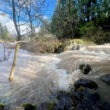Sean C. Morgan
Deciding whether to cancel school, delay school or go ahead and have school is an overnight process involving multiple School District staffers trying to make a judgment call based on existing road conditions and predictions about what the weather will do.
The results of that process have been evident to local residents as Sweet Home School District canceled school for snow four times in the past two weeks – starting with a two-hour delay one day last week that eventually resulted in cancellation.
The district has had five snow days so far this year.
Supt. Tom Yahraes said he starts keeping a close eye on weather forecasts “if we have a sense the weather might be bad and affect safety.”
“If we can make a good determination the night before, it’s good for students, it’s good for parents and it’s good for staff (40 percent of whom commute to Sweet Home from out of the district),” Yahraes said. “If I can (gather) good data, I believe it’s best to get the information out to the community.”
That way parents can prepare, he said.
Two weeks ago, district officials were able to make the call the night before based on a preponderance of information, Yahraes said. More often, they’re watching the weather and roads throughout the night.
Last Thursday, March 7, the district started with a two-hour delay called at about 5:25 a.m., but Yahraes said while conditions in town slightly improved, based on the morning forecast, staff determined that temperatures would not be warm enough to improve road conditions during the window of travel, from 7:30 a.m. to 9 a.m., for a delayed start.
School buses need to be on the road by 7:25 a.m. on a delayed start, Yahraes said, noting that nearly half of Sweet Home students ride buses, many in hilly areas.
Reliable reports from his contacts indicated the roads weren’t safe, Yahraes said, although he expected the weather to warm up later and the main arteries would be good to use.
“We were getting information these places were bad, and when transportation and the county say that, we don’t move.”
Yahraes said he would generally prefer to err on the side of safety.
“I take a lot of time trying to make the best decision,” Yahraes said. “Working with weather is its own variable.”
The snow is beautiful and fun, Yahraes said – “kids are on the hill having a good time”
Once he makes the final decision, he notifies his administrative assistant, Julie Emmert, who posts to Facebook and Flashalert; The New Era, which also posts the information as soon as possible; and then the district phone tree.
Generally, by 3:30 a.m., Transportation Supervisor Cheryl Hicks has a group of three drivers who check out the holly areas, she said. That includes Berlin, Pleasant Valley, Riggs Hill, Fern Ridge, Springer Road, Upper Calapooia, Crescent Hill, Marks Ridge and Cascadia.
“If I think there’s going to be a possibility of inclement weather, I’ll set my alarm for 4 a.m.,” Yahraes said, noting that by then, Hicks’ team is already checking things out a half hour earlier.
Hicks checks in with Linn County road officials to find out conditions in the rural areas across the district, while Yahraes checks in with the police chief, student resource officer and Sgt. Jason Van Eck, who also is a member of the School Board about road conditions in the city.
“If it’s really slick on the lower roads, it’s going to be worse on the higher routes,” Hicks said.
Yahraes also communicates with superintendents in neighboring districts, although their weather patterns don’t necessarily indicate what will happen in Sweet Home, he said. Sweet Home typically has fewer cancellations than neighboring districts because the weather is often different.
Yahraes has to make the call whether to delay school by 5:25 a.m., he said. “If we feel the roads are unsafe, we’ll institute a two-hour delay.”
Delaying school gives the district more time to gather information and to assess the roads, and it gives the city and county more time to put down cinder and deicer, he said. The delay gives people more time to drive slowly on the way to work.
Two weeks ago, with three days off, power outages also were an issue, he said. Both Foster and Holley elementary schools had long power outages.
By the fourth day, while snow was still piled high along roadsides, the roads had enough cinder and were dry, Yahraes said, so schools opened.
The forecast didn’t show any precipitation, Yahraes said. Lebanon was fogged in, and everything was glazed over there.
As the day progressed, the road conditions had changed in Sweet Home, and the weather was a lot colder later, Yahraes said. He kept tabs on buses and schools that morning, and there were no weather-related problems.
School Board Chairman recalled that day. He was able to drive full speed to work in the Albany area early that morning, while Hicks and Yahraes were looking at the roads, but then the conditions worsened.
“Those conditions can change in a heartbeat,” Redick said, so it’s not a light decision.
What causes Yahraes the most concern is black ice, which is “no fun. You can’t see it.”
“It’s something that I take very seriously,” Yahraes said, noting that there is no superintendent playbook or class to learn how to make the decision. “We spend a lot of time going over the factors, the data.”





